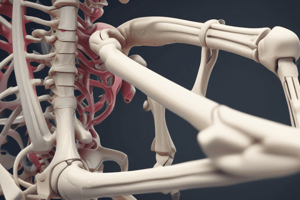Podcast
Questions and Answers
How many bones are there in one foot?
How many bones are there in one foot?
26
What are the three groups of bones in the foot?
What are the three groups of bones in the foot?
Phalanges, metatarsals, tarsals
How many phalanges does the large toe have?
How many phalanges does the large toe have?
2
What bones consist of the metatarsal bones?
What bones consist of the metatarsal bones?
Which metatarsal is commonly a site for trauma?
Which metatarsal is commonly a site for trauma?
What is the largest and strongest bone of the foot?
What is the largest and strongest bone of the foot?
Which tarsal bone is located between the lower leg and the calcaneus?
Which tarsal bone is located between the lower leg and the calcaneus?
How many cuneiform bones are there in the foot?
How many cuneiform bones are there in the foot?
Match the tarsal bones with their functions or characteristics:
Match the tarsal bones with their functions or characteristics:
The first cuneiform is also known as the ______.
The first cuneiform is also known as the ______.
Flashcards are hidden until you start studying
Study Notes
Foot Anatomy
- The foot consists of 26 bones, classified into three groups:
- Phalanges: 14 bones (toes)
- Metatarsals: 5 bones (instep)
- Tarsals: 7 bones
Phalanges
- The large toe (first digit) contains two phalanges: proximal and distal.
- The other toes (2nd-5th digits) contain three phalanges each: proximal, middle, and distal.
Metatarsal Bones
- Each metatarsal has three parts: head, body, and base.
- The fifth metatarsal is a common site for foot trauma.
Joints
- Phalanges: The first digit has interphalangeal (IP) joints, including distal interphalangeal (DIP) and proximal interphalangeal (PIP) joints.
- Metatarsals: Features metatarsophalangeal (MTP) joints, with tarsometatarsal (TMT) joints at their bases.
Tarsal Bones
- Seven tarsal bones in the proximal foot, mnemonic: "Come to Colorado (the) next 3 Christmases":
- Calcaneus (os calcis)
- Talus (astragalus)
- Cuboid
- Navicular (scaphoid)
- Three cuneiforms: first, second, and third.
Calcaneus
- The largest and strongest foot bone.
- Articulates anteriorly with the cuboid and superiorly with the talus, forming the subtalar (talocalcaneal) joint.
Talus
- The second-largest tarsal bone, located between the lower leg and calcaneus.
- Transmits body weight through ankle and talocalcaneal joints.
- Articulates with the tibia, fibula, calcaneus, and navicular.
Navicular
- Articulates posteriorly with the talus and anteriorly with three cuneiforms.
Cuneiforms
- First cuneiform (medial): the largest, articulates with the first metatarsal.
- Second cuneiform (intermediate): the smallest, articulates with the second metatarsal.
- Third cuneiform (lateral): articulates with the third metatarsal distally and cuboid laterally.
- All three cuneiforms articulate with the navicular proximally.
Summary of Tarsal Articulations
- Calcaneus: articulates with cuboid, talus.
- Talus: articulates with tibia, fibula, calcaneus, navicular.
- Navicular: articulates with talus, three cuneiforms.
- Medial Cuneiform: articulates with navicular, first and second metatarsals, intermediate cuneiform.
- Intermediate Cuneiform: articulates with navicular, second metatarsal, medial and lateral cuneiforms.
- Lateral Cuneiform: articulates with navicular, second, third, and fourth metatarsals, intermediate cuneiform, and cuboid.
- Cuboid: articulates with calcaneus, lateral cuneiform, fourth and fifth metatarsals.
Studying That Suits You
Use AI to generate personalized quizzes and flashcards to suit your learning preferences.




